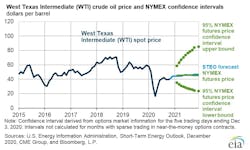The US Energy Information Administration (EIA) expects Brent prices to average $49/bbl in 2021, it said in its latest Short-Term Energy Outlook (STEO), $2/bbl more than forecast in last month’s STEO. An average of $43/bbl is expected in fourth-quarter 2020. The forecast for higher crude oil prices next year reflects EIA’s expectation that while inventories will remain high, they will decline with rising global oil demand and restrained OPEC+ oil production.
In addition, EIA forecasts Brent prices will average $47/bbl in first-quarter 2021 and rise to an average of $50/bbl by the fourth quarter. The first-quarter 2021 average is $5/bbl more than forecast in last month’s STEO, and the fourth quarter average is $1/bbl more. Higher expected first quarter prices reflect steeper expected global oil inventory draws as a result of the Dec. 3 OPEC+ decision to limit its previously planned production increases in January 2021. EIA expects high global oil inventory levels and surplus crude oil production capacity will limit upward pressure on oil prices through much of 2021.
In the December issue of the report, EIA forecasts OPEC crude oil production will average 27.5 million b/d in 2021, up from an estimated 25.6 million b/d in 2020. The increase reflects OPEC’s announced potential increases to production targets and production increases in Libya.
At the Dec. 3 meeting, OPEC+ participants decided to limit oil production increases planned for January 2021, noting a production target increase of 500,000 b/d instead of the initially planned 2.0 million b/d (OGJ Online, Dec. 3, 2020). The group will assess the state of global oil markets and petroleum demand monthly, adjusting targets based on market conditions. EIA now forecasts OPEC crude oil production will average 25.7 million b/d in first-quarter 2021, which is 1.7 million b/d lower than forecast in the November STEO and reflects the announced changes to OPEC+ targets and more effective assumed compliance with targets.
EIA estimates that the world consumed 95.6 million b/d of petroleum and liquid fuels in November, which is down 6.3 million b/d from November 2019 but up from the third-quarter 2020 average of 93.5 million b/d. EIA forecasts that global consumption of petroleum and liquid fuels will average 92.4 million b/d for all of 2020, which is down by 8.8 million b/d from 2019, before increasing by 5.8 million b/d in 2021.
Estimated US crude oil production was 11.2 million b/d in November, which is up from 10.9 million b/d in September. The increase mostly reflects greater production in the US Federal Gulf of Mexico after hurricane-related disruptions. EIA expects that US crude oil production will decline to less than 11.0 million b/d in March 2021 mostly because of falling production in the Lower 48 states, where EIA expects declining production rates at existing wells will outpace production from newly drilled wells in the coming months.
According to EIA, crude oil production in the Lower 48 states will increase from 8.7 million b/d in February 2021 to 9.1 million b/d in December 2021, as drilling increases in response to rising oil prices. This increase contributes to total US crude oil production reaching 11.4 million b/d in December 2021. On an annual average basis, EIA expects US crude oil production to fall from 12.2 million b/d in 2019 to 11.3 million b/d in 2020 and 11.1 million b/d in 2021.


